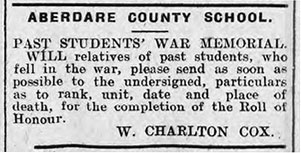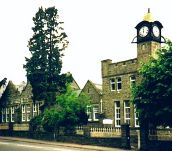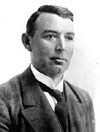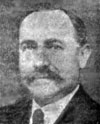Press Account of the Unveiling Ceremony
of the First World War Memorial Plaque
From The Aberdare Leader, Saturday October 9th, 1920
ABERDARE BOYS’ COUNTY SCHOOL.
Unveiling of Memorial Tablet
The ceremony of unveiling the memorial tablet to Past Students killed in the war took
place at the Boys’ County School on Thursday evening. Councillor William Thomas
presided over a large and representative gathering. Letters regretting inability to be
present were read from the High Constable, Mr. D.R. Llewellyn, J.P., Councillor Stonelake,
chairman of the School Governors, and from a number of local citizens.
Mr. W. Charlton Cox, M.A. the headmaster, who described the inception of the scheme,
pointed out that no less than forty-one old students of the school had made the supreme
sacrifice.
The Rev. T. Madoc Jeffreys, representing the Governors, paid a glowing tribute to the
memory of the glorious dead. He also complimented the Memorial Fund Committee upon the
twofold purpose of their scheme of preserving the memory of the departed heroes, both in
imperishable brass and also by setting aside a fund for providing University Scholarships
to deserving students of the school.
After Mr. Emrys Prosser had spoken on behalf of the Past Students’ Association, the
chairman called upon Mr. C.B. Stanton, M.P., to unveil the Memorial Tablet. A very
affecting incident occurred in the course of his speech. Mr. Stanton, whose son, the late
Lieut. Clifford Stanton, is among those whose names are inscribed on the Memorial Tablet,
was so overcome with emotion that he was for a time unable to proceed with his speech.
The draping having been removed, a beautiful brass tablet, surmounted by the arms of
the school, was exposed to view. It is situated in a central position on the wall, facing
the windows in the Central Hall of the school, and should prove a source of great
inspiration to successive generations of scholars.
The religious service, which was of a very impressive nature, was conducted jointly by
the Vicar of Aberdare and the Rev. T. Madoc Jeffreys. The School Choir, under the
conductorship of Mr. E. Ogwen Williams, gave a beautiful rendering of the Recessional. The
Memorial Fund is still open, and subscriptions should be sent to the hon. sec., Emrys
Prosser, Anwylfan, Trecynon.
Notes
A photograph of the plaque in its original position can be seen in this 1922 photograph of the
Central Hall.
Mr. D.R. Llewellyn, (1879–1940), became Sir D.R.
Llewellyn in 1922. He was the eldest son of Mr Rhys Llewellyn of Bwllfa House, Cwmdare. D.R.
Llewellyn lived at Goytre, 47 Llewellyn St., then at Fairfield, off Monk Street, and finally
at The Court, St. Fagans. The Llewellyn family were originally mining engineers and later
coalowners. The baronetcy is today, (2014), held by the 5th Baronet,
Sir “Roddy” Llewellyn.
Councillor Stonelake, (1873 – 1960), was Mr Edmund
Stonelake of Herbert Street, Foundry Town. He was Chairman of Governors 1919–1922 and
1946–1948. He was an important figure in establishing the Labour Party in the Merthyr
Boroughs constituency, (a two-member constituency which consisted of Merthyr and parts of the
parish of Aberdare). An autobiography, The Autobiography of Edmund Stonelake, edited
by Anthony Mor-O’Brien was published by Mid Glamorgan County Council in1981. He also
has an entry, written by former ABGS pupil D. Leslie Davies, in the Welsh Biography
Online,
here.

Rev. T. Madoc Jeffreys, (1877–1934), came to
Aberdare in 1914 as pastor of Tabernacle Church, at the corner of Duke Street and Station
Street. He began his career as a teacher, but so rapid was his success that he was the
headmaster of an elementary school at the age of 24, after having served as second master at
Bedwellty Pupil Teachers’ Centre and as teacher of chemistry at the Ebbw Vale County
School. It was the Revival of 1904 that finally induced him to enter the ministry. He was
ordained in 1905 at Tabernacle Church, Waunllwyd, Ebbw Vale, where he enjoyed a highly
successful ministry for nine years. At Aberdare he was the initiator of the Free Church
Girls’ Club in Canon Street, which became a flourishing institution of over 250
members; was instrumental in bringing the YMCA into the town; was a member of Glamorgan
County Council; and President of the English Free Church Council in Aberdare. He left
Aberdare around 1924 for Cardiff, and later retired to London to spend more time on his
missionary work.
As a result of an incident on September 12th, 1934 at St. James’s Park Underground
Station, London, he sustained severe injuries which resulted in his death soon afterwards at
Westminster Hospital. He was 56 years old. On the evidence of the “motorman”,
(the train diver), the Coroner concluded that the Rev Jeffreys had taken his own life. At
this period he lived at Beulah Hill, London, SE19. He left a widow, Margretta Ann Jeffreys
and a daughter Mrs Lilian M. (Rita) Bartrop.

Charles Butt Stanton, (1873 – 1946) was an
Aberaman-born trade unionist and politician. After the death of Keir Hardie in 1915, he won
the by-election and served as one of the two MPs for the Merthyr Boroughs Constituency until
1918. He became the first Member of Parliament in the following general election for the
separate constituency of Aberdare when it was established in 1918. He lost the seat in 1922
to the Labour Party candidate George Hall. Stanton’s life was eventful and one of
tremendous contrasts: from spending six months in prison in 1893–94 for
“feloniously and maliciously shooting at Samuel Rutter, a police inspector,” near
Aberaman during a miners’ dispute; a short period as a docker in London; AUDC
Councillor; MP 1915–22; a film actor in the 1920s & 1930s when he lived in
Hampstead. A concise summary of his career can be found in the Welsh Biography Online
at this link; and a
more comprehensive account written by Reverend Ivor T. Rees of Swansea is in the Merthyr
Historian, Vol. 25 (2013), p. 161-179.

Emrys Prosser, (1896–1967), was a faithful and
long-serving member of the PSA committee. He attended the school between 1911 and 1914, when
he left to become an uncertificated teacher. His home Anwylfan was in Harriet Street.
Eventually he became a secondary school teacher in Aberdare. Emrys is shown left in 1947,
some 27 years after the event described above.
James Abraham Lewis, B.D., was the Vicar of Aberdare, and
is mentioned in the press report as having jointly conducted the religious service. He served
in Aberdare from 1914 until 1931. He was married to the niece of the influential landowner
and coalowner, James Lewis of Plasdraw House. Rev Lewis is pictured, left, at the time
of his arrival in Aberdare in 1914.
Mr W. Charlton Cox & Mr E. Ogwen Williams : Notes
about these members of school staff are to be found on this web-site in the
Headmasters’ and Teachers’ sections respectively.
Names for the Plaque were communicated to the PSA and to
the school by letter, word of mouth, but also by appeals in the press such as the one shown
below that appeared in The Aberdare Leader of 10 October 1919. Adverts would
have been placed in newspapers beyond the local area as several families had left the
district by 1919, up to 16 years or so after the date when their children left the school.
Even so, the information on the plaque for the last four past students is either incomplete
or not wholly accurate.
We have no information about any past pupil who may have been omitted completely.

Thanks to Steven Graham & Geoffrey Evans for helping with this item.
Back to previous page








